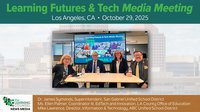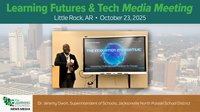When we decided to launch a STEAM program at our preK-8 school, I spent more than a year researching, visiting and speaking with educators from dozens of schools across the country. I did an extensive search to find the right solution, and it just so happened that one was right here in our own backyard.
Implementing the hands-on STEAM curriculum platform made sense for our school, which began using it for the current school year. Similar to many schools nationwide, we were new to STEAM at the time. Our new platform quickly became a part of that initiative, which included a focus on empowering teachers to lead STEAM project-based learning.
Measuring the Positive Impacts
Today, we’re using the STEAM platform in grades K-8. We have a STEAM teacher, and then our classroom teachers—who are all really enthused about this initiative—come in to lend a helping hand. Here are five benefits we started seeing almost immediately once we selected and started working with a STEAM curriculum partner:
- Get all teachers and subjects involved in STEAM. People often like to say that programs are cross-curricular, but TinkRworks truly is. Multiple teachers in different subjects can be involved in each project. For example, our art teacher and music teacher are very excited to participate in STEAM education. We've actually had to rework the schedule to coordinate dates and times so that their music and art class lessons can coincide with one another. We also have a computer teacher who is integrating the coding component into the learning.
- Prepare students for what’s coming next. Teachers are engaging students in unprecedented ways and preparing career-ready innovators. The projects provide a great balance, offering simplicity to our teachers and a sense of accomplishment to our students. STEAM is going to be a pivotal part of students’ development going forward. Students graduate from our school after finishing the eighth grade, but they’re going to need these skills to succeed in high school, college and beyond because that’s where we’re headed as a society. The integration with math and science is going to be a pivotal part of their development going forward.
- Build those all-important soft skills. COVID-19 really changed students’ socialization habits and skills, which are now much more limited than they were pre-pandemic. We’re using STEAM projects to not only give students a chance to engage in conversations, but to also help them learn how to provide constructive criticism to one another. Being able to give and receive feedback is a really important skill. If students can learn this earlier rather than later, we see that as a big benefit.
- Provide built-in curriculum for instructors. On the teacher's end, the curriculum is extremely robust. We're now integrating teachers who don’t have a formal background in STEAM. The platform’s lesson planning and curriculum is so robust and flexible that it allows teachers to integrate their personal touches or remove items or add them. This makes the integration into our current curriculum much easier.
- Encourage collaboration and group problem-solving. We work in collaborative groups on a daily basis; all of my decisions involve an administrative, IT or religion team. We've put a lot of effort into group projects because of that, and our STEAM platform integrates seamlessly with the new trend of working as a team, having constructive criticism conversations and doing problem-solving with their peers—which is truly a life skill.
It Changes Everything
We know that STEAM is an area that not all teachers are well-versed in, but we also know that it’s something everyone is focused on right now. Being able to get everyone onboard and excited about STEAM is important to us, and it’s something we’ve been able to accomplish using our curriculum platform. When it’s something that teachers want to do and are enthused about, it changes everything.
About the Author
Paul Smith is the principal of St. Michael School at the Archdiocese of Chicago Catholic Schools in Orland Park, Ill.











